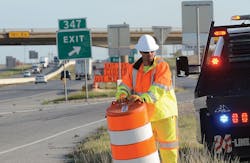By: James Baron
One year, Life magazine dubbed it, “the loneliest road in America.”
It was Nevada’s U.S. Rte. 50, and to this day it still can oftentimes be a vast desert wasteland that surrounds hundreds of miles of lonely asphalt. At times, traveling this road can be so mundane that a motorist might innocently drift away, only to be brought back to reality by another vehicle, stray wildlife or even a surprise roadway work zone, all in the middle of what seems like nowhere.
So, who is telling a lonely portable message board way out there amidst the sand and dust to flash and warn motorists they are about to enter a work zone? Intelligent transportation systems, or ITS. It’s been around for years, but only recently has it seen an upward surge in life-saving applications all over the country. There’s still not much that can be done to warn a motorist of a crossing jackrabbit on a desert highway, but technology does exist today that can inform the motorist when he or she is approaching a hazard or a flagger, or when there is a backup of vehicles ahead that is merging down to one lane into a work zone.
The beauty of these unattended systems is they’re providing motorists with vital information automatically, in real-time with no help from a human operator. It’s information based on vehicles present—or not present. No vehicles = no message. If a queue is developing, everyone approaching will know it by a warning flash on a portable message sign. As a result, motorists take the necessary precautions to proceed slowly, or slow to a safe stop.
ITS systems have shown they can reduce or completely eliminate rear-end collisions by reducing queuing, congestion and confusion by giving motorists information far upstream, away from the actual work. More advanced systems also can give motorists travel times to the minute and other information, which undoubtedly relieves frustration and uncertainty when traveling. They can even inform motorists to take an alternate ramp or route when there’s trouble or a delay ahead.
Game-changing
Exposure to and information regarding ITS technology as employed in work zones received a boost in recent months in the form of a Texas A&M Transportation Institute (TTI) study titled Safety Effects of Portable End-Of-Queue Warning System Deployments at Texas Work Zones.
The study showed a tremendous success rate with end-of-queue (EOQ) ITS warning systems, estimating that they can reduce crashes “44% from what they would have otherwise been if the system had not been used.” The study also concludes “the use of the EOQ warning system at nighttime lane closures reduced crash costs by $1.36 million over the analysis period. This equates to $6,313 in crash cost savings per night of deployment.”
A portable ITS system, like the one deployed on U.S. 50, is relatively inexpensive, easy to use, highly portable and can be moved manually by workers if the taper of the work zone changes.
Joe Jeffrey, founder of Sacramento, Calif.-based Road-Tech Safety Services Inc., said these types of portable ITS systems are what works most effectively for state construction projects. “When the taper is moved, the queue changes. You simply move the ITS device a half-mile beyond what you believe is the worst-case scenario for queuing and the message boards deliver the message.”
Jeffrey also credits the TTI study for helping the roadway safety industry deploy more of these systems across the country to help save lives.
“I’ve been in the ITS business for 15 years, and up until now we didn’t have a lot of data to prove how effective our systems were in reducing crashes when joined with other devices, such as portable message boards and portable rumble strips,” he said.
There is a system installed in drums that are placed every half-mile to 1 mile apart beginning at the taper as part of the work-zone temporary traffic-control package. Real-time information from the system is instantly relayed to nearby portable message boards to alert motorists of upcoming hazards. The system also can be mounted to arrow boards, on trailers, masts or onto other stable roadside objects.
“It gives motorists the actual vehicle speed at the taper relevant to the activity on the road,” said Ross Sheckler, managing partner of iCone Products LLC. “States wanted a simple, faster, less data-rich system to deploy, and they wanted it to be affordable.” The system’s “instant ITS” function, which uses a traffic beacon, came to the New York State Department of Transportation’s rescue when it wanted to solve work-zone problems by focusing on the safety of roadway workers by using simpler, less data-rich information that’s faster to deploy and much more affordable than fixed ITS systems.
“When the workers move farther down the road, the sensors in the drums are moved with them,” Sheckler said. “Having the device placed where it’s relevant to where the workers are is the spot where vehicle backups are the concern.”
Work-zone Delivery Engineer Chris Brookes of the Michigan Department of Transportation is an ally of this technology and he considers the potential of work-zone ITS systems as being similar to the qualities of a newborn baby.
“It’s something new and not a lot of people have a total grasp of the full capabilities of these systems,” Brookes said. “It’s growing so fast and they are capable of so much, that it’s changing the way work zones are designed. These systems give data and focus in real time that we have never had before.”
Brookes feels the next step in the progress of these systems is getting the information into the vehicle for the motorist to use, similar to other in-vehicle devices and systems that are already in use.
“That will be the game changer,” Brookes said.
According to Sheckler, representatives from his company are already speaking to those automobile manufacturers that have a keen focus on vehicle autonomy. They also are looking at satellite radio services as possible hosts of work-zone and roadway safety information.
“Every vehicle on the road is going to encounter a work zone,” Sheckler said. “If people cannot drive safely through work zones, that’s not giving full service to the automobile customer.”
For now, ITS provides motorists important information outside the vehicle that allows them to make actionable, life-saving decisions as they drive.
“There is no way we can go to autonomous vehicles without knowing who is working on the roads and where they are,” Sheckler said. “If motorists are not aware and we’re just setting up flagging operations without motorists being informed, the consequences will be deadly.”
Systemic application
In terms of performance measures, the Federal Highway Administration’s (FHWA) website reports that state transportation officials have developed numerous methods to measure and monitor work-zone performance, and also have implemented web-based resources to inform the public about the performance of roadway projects and the transportation system as a whole. Several examples are posted on their website.
The FHWA Work Zone Mobility and Safety Program contains a checklist of five possible factors for assessing the feasibility of work-zone ITS. A score of 30 or greater on the checklist means, “ITS is likely to provide significant benefits relative to costs for procurement.” Federal funding for ITS projects also may be available through the FHWA’s State Transportation Innovation Councils (STIC) Incentive Program or through Accelerated Innovation Deployment grants under FHWA’s Every Day Counts program.
Fixed or more permanent ITS systems also are in place at many locations across the country, saving lives and routinely helping to ease congestion and speed mobility through troubled areas.
There is a system which uses a variety of devices that provide road conditions far enough “upstream” in the work zone to allow motorists to take action or make alternative travel decisions if the delay is going to be significant.
The system utilizes multiple sensors that capture, by individual lane, vehicle speeds, volumes and classifications, then compile all of that information into a package that informs motorists of hazards or delays that lie ahead on the roadway.
“Before leaving home on a trip, motorists can visit a DOT’s website or call the state’s 5-1-1 system to view cameras or receive the latest travel information provided by this system. Or, if the motorist is already on the road, they can receive the information behind the wheel from fixed or portable message signs,” said Todd Hartnett, director of business development and ITS specialist for Work Area Protection at ASTI Transportation Systems Inc.
The system also can be deployed in small, short-term temporary projects, or installed as part of large permanent system in places such as Boston’s busy roadway and tunnel system.
A portable radar sensor is mounted on portable sign stands, utilizes software that analyzes traffic data and provides real-time information to the motoring public, DOT project managers, agencies, traffic management centers and public websites.
“In Los Angeles on I-405, also known as ‘Carmageddon,’ the system assisted the rerouting of traffic congestion problems significantly,” said Hartnett. This project required a complete shutdown of one of the busiest highways in the U.S. and its deployment helped to cut down on the closure times.
Hartnett also agrees with his colleagues that in-vehicle information is critical to roadway safety.
“Today, there’s more information on a smart phone and in a car, there are more sensors and data that are being collected everywhere. Everything is moving towards in-vehicle and in-hand,” he said. “[But] until every vehicle is connected, you’re still going to need equipment in the field.”
Michigan’s Chris Brookes also is familiar with this system.
“The sensors and software provide great information including volume reports, times of day, speed and so forth, so we can make critical decisions. [The system] allows us to ‘slice and dice’ traffic data any way we like. It’s a great search tool for an engineer,” he said.
And like Michigan, the portable radar sensor has achieved tremendous ITS success in Illinois, Texas, Ohio, Indiana, Tennessee, Massachusetts, New Hampshire and elsewhere.
The roadway safety industry has permanent or portable ITS systems that do so much, save so many lives, prevent collisions and now have the data to support their success. So one might ask, “Why isn’t ITS everywhere?”
Thanks in large part to TTI’s recent report, and to the proven success of existing ITS applications across the country, if it hasn’t happened already, hopefully ITS will be coming soon to a roadway near you.
About The Author: Baron is director of communications for the American Traffic Safety Services Association (ATSSA).



